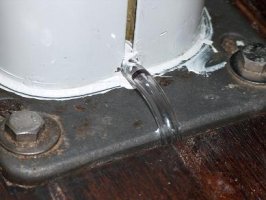Whenever it rains, I get a pool of water INSIDE my keel stepped aluminum mast. There is no drain into the bildge so the water slowly seeps out and soaks my sole and carpet and some of it eventually finds its way into the bildge.
There is no drain into the bildge so the water slowly seeps out and soaks my sole and carpet and some of it eventually finds its way into the bildge.
As I see it I have 3 options:
1. Climb the mast and attempt to seal all major entry points. Obviously it will never be watertight but I figure there is one BIG hole (at the top?) where most of the water is getting in.
2. Rig a drain into the bilge. I may be able to drill a hole into the bilge but this is tough, mostly because I don't know what the mast step is made of. It is not fiberglass. It looks like some kind of concrete, or maybe lead. Does anyone know what the stringers and mast step are made of on a 1978 Ericson 34t?
3. Re-route the electrics to exit the mast at the deck and seal the mast there. Not a very attractive option as it would require drilling large holes in the mast at the deck AND drilling holes in the overhead to re-route the cables.
Does anyone have any experience with this? I can't imagine that production boats today would let the mast leak all over the interior. What is the usual remedy? Any help is appreciated. Thanks.
 There is no drain into the bildge so the water slowly seeps out and soaks my sole and carpet and some of it eventually finds its way into the bildge.
There is no drain into the bildge so the water slowly seeps out and soaks my sole and carpet and some of it eventually finds its way into the bildge.As I see it I have 3 options:
1. Climb the mast and attempt to seal all major entry points. Obviously it will never be watertight but I figure there is one BIG hole (at the top?) where most of the water is getting in.
2. Rig a drain into the bilge. I may be able to drill a hole into the bilge but this is tough, mostly because I don't know what the mast step is made of. It is not fiberglass. It looks like some kind of concrete, or maybe lead. Does anyone know what the stringers and mast step are made of on a 1978 Ericson 34t?
3. Re-route the electrics to exit the mast at the deck and seal the mast there. Not a very attractive option as it would require drilling large holes in the mast at the deck AND drilling holes in the overhead to re-route the cables.
Does anyone have any experience with this? I can't imagine that production boats today would let the mast leak all over the interior. What is the usual remedy? Any help is appreciated. Thanks.

